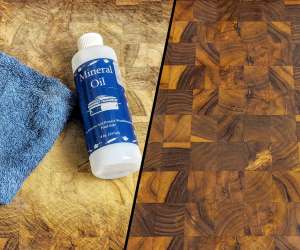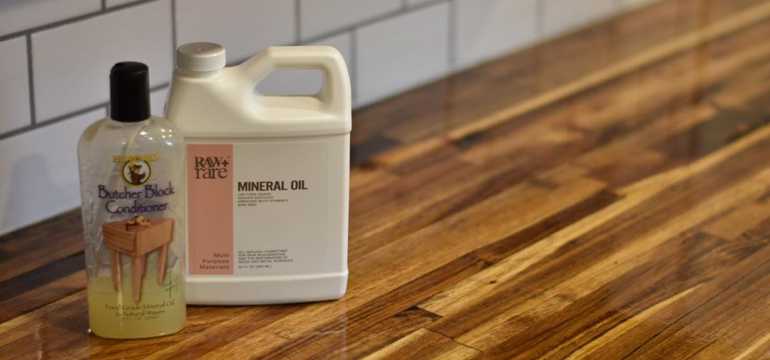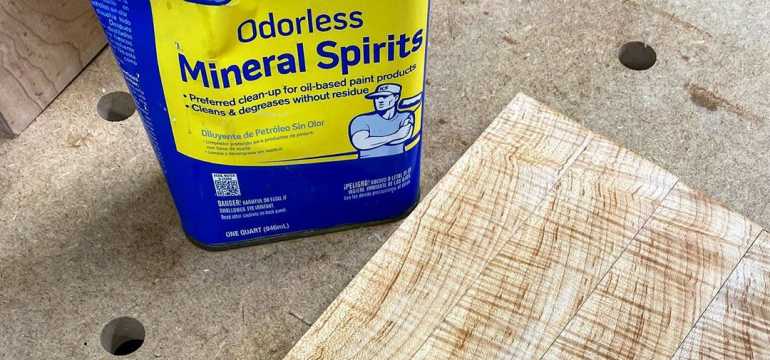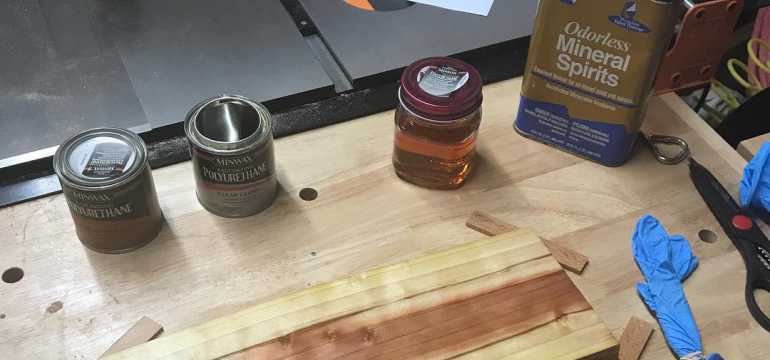When you are working on a project, especially if it’s one of your first DIY projects, you will encounter a lot of different terms. Some of them may be so similar that you might wonder if they are interchangeable: mineral spirits and mineral oil, for example. But is mineral spirits the same as mineral oil? The answer is a resounding no, and that fact can make quite a big difference in the process and results of your DIY project.
In this guide, we will review mineral spirits vs. mineral oil and enlighten you about some key differences between them. We will also talk about the uses for mineral oil and for mineral spirits in their respective capacities.
What Is Mineral Oil?
 Mineral oil is a colorless and odorless mixture of higher alkanes, taken from a mineral source. Another way to phrase it is that mineral oil is a by-product, specifically taken from petroleum distillate. This “petroleum distillate” factor is what differentiates mineral oil from vegetable oils.
Mineral oil is a colorless and odorless mixture of higher alkanes, taken from a mineral source. Another way to phrase it is that mineral oil is a by-product, specifically taken from petroleum distillate. This “petroleum distillate” factor is what differentiates mineral oil from vegetable oils.
Mineral oil is not a perfect name for this substance, since it is not technically made of pure minerals. You may also see it called paraffin oil, white oil, liquid paraffin, or liquid petroleum.
When you think of petroleum, you might think of car gas, and that’s a fair comparison. Mineral oil is basically an oily liquid left over from the process of turning crude oil into gasoline. Obviously, the mineral oil is heavily refined before it is deemed safe and ready for the market. Really this product is more similar to petroleum jelly than gasoline. It is simply in liquid oil form rather than a smeary paste form like the jelly. Baby oil is essentially mineral oil with perfume and color added.
Common Uses for Mineral Oil
Mineral oil has many different uses. As part of our endeavor to show the difference between mineral oil and mineral spirits, it’s important to review some of these uses.
Mineral oil is well known to have a laxative effect, so it is sometimes used for that purpose in the medical field. It is present in various cosmetics, including cold creams, ointments, and baby lotion. You can use a little bit of mineral oil to take off a temporary tattoo or to remove certain kinds of makeup. It is also helpful for softened and soothing cracked feet or for medicating various kinds of skin irritation.
Some other niche uses for mineral oil include mineral oil as brake fluid or as an agent to help find leaks in automotive EVAP systems. It is also present in many kinds of scented candles.
 Now we’re getting down to the uses that you may be more interested in as a woodworker or DIYer.
Now we’re getting down to the uses that you may be more interested in as a woodworker or DIYer.
Mineral oil can be used to treat butcher block countertops, as it has a protective and preserving effect. People often use it to treat cutting boards, wooden utensils, wooden salad bowls, and similar wooden items that are going to be used for food handling purposes. The application of mineral oil helps to prevent the wood from absorbing water in the future.
Mineral oil is also sometimes used to treat poker chips. Stoneworkers sometimes use it to polish alabaster, and various workers apply mineral oil while they are honing and sharpening any tools with bladed edges. The mineral oil helps to prevent rusting of the blades.
Mineral Oil as a Finish for Wood
 As you consider the benefits of mineral oil, you are most likely thinking of it as a type of wood finish. This non-toxic, clear, odorless substance does work fairly well on certain wood surfaces. It does not offer anywhere near the level of protection that a polyurethane finish does, but it can supply minimal protection.
As you consider the benefits of mineral oil, you are most likely thinking of it as a type of wood finish. This non-toxic, clear, odorless substance does work fairly well on certain wood surfaces. It does not offer anywhere near the level of protection that a polyurethane finish does, but it can supply minimal protection.
When you use mineral oil on wood, you can expect the oil to seep into the wood. As it saturates the wood, you will likely need to use multiple coats of the mineral oil to get the full protective effect. You want the wood to be thoroughly saturation for optimum benefit.
Mineral oil prevents water from saturating the wood, though it is not technically waterproof. It offers a barrier against humidity, and it also prevents the growth of mold. Its presence may help to protect the wood against some low-level weathering and wear, although the quality of its defensive properties is fairly minimal. Experts suggest at least two coats, possibly more, and you should sand lightly between each successive coat after allowing the previous coat to dry thoroughly.
What Are Mineral Spirits?
 Mineral spirits is the plural form for this substance or category of substances, while “mineral spirit” is technically the singular form. A mineral spirit, or white spirit, is not to be confused with mineral oil. They may have vaguely similar origins, but mineral spirits are not food grade or food safe and should not be ingested, applied to the body, or used on surfaces from which food will be directly consumed.
Mineral spirits is the plural form for this substance or category of substances, while “mineral spirit” is technically the singular form. A mineral spirit, or white spirit, is not to be confused with mineral oil. They may have vaguely similar origins, but mineral spirits are not food grade or food safe and should not be ingested, applied to the body, or used on surfaces from which food will be directly consumed.
Mineral spirits are also known as a turpentine substitute. They may be called petroleum spirits since, like mineral oils, they are derived as a by-product during the refinement process of petroleum. Mineral spirits are clear and colorless, and they are frequently used as a type of organic paint thinner. You will find mineral spirits present in lacquers, varnishes, paint, aerosol sprays, asphalt products, and wood preservatives.
Common Uses for Mineral Spirits
 If you need paint or varnish to be thinner or to have slightly different properties, mineral spirits are usually the way to go. Mineral spirits are often used by artists to thin out paints and achieve different colors and textures. They can also be used to thin ink. Mineral spirits may be applied to silk-screening machines and screens to remove the clogged or hardened ink and paint.
If you need paint or varnish to be thinner or to have slightly different properties, mineral spirits are usually the way to go. Mineral spirits are often used by artists to thin out paints and achieve different colors and textures. They can also be used to thin ink. Mineral spirits may be applied to silk-screening machines and screens to remove the clogged or hardened ink and paint.
Sometimes mineral spirits are employed within gauges or compasses that involve liquid as a means of bringing the liquid to the right consistency. Some types of mineral spirits or white spirits may be used in portable stoves when kerosene is not available. Basically, mineral spirits are a lighter grade of the product kerosene.
White spirits or mineral spirits may also be poured into parts of car engines or other engines since their properties allow for the dissolution of sludge and buildup inside those engine parts. You’ll often see mineral spirits (either by that name or a similar title) on the label of products designed as oil or fuel additives. For extremely precise lathes, like those used in diamond turning machines, mineral spirits are typically employed as a type of cutting fluid to ease the process.
Qualities of Mineral Spirits
In their usual form, mineral spirits tend to smell rather unpleasant, like kerosene. However, there are more refined varieties of mineral spirits that have been further treated to eliminate some of the more toxic components. Taking out the toxins also tends to reduce or eliminate the strong smell. However, that doesn’t necessarily mean that mineral spirits are safe.
They are still considered an irritant to human skin and lungs. If someone is exposed to high levels of concentrated mineral spirit vapors, they will suffer from slowed reaction time, clumsiness, nausea, and eventually dizziness and possible unconsciousness. It is important to deal with mineral spirits, and the substances that contain them, in a well-ventilated space.
Mineral Spirits vs. Mineral Oil: Overview
 So when we ask the question, “Is mineral spirits the same as mineral oil?” we now know that the answer is “Definitely not.” Mineral oil can often be food-grade and food-safe, which means it’s okay to use on dishes, utensils, and similar items. It can also be used on the body to treat dry skin, callouses, cracked areas, and more. And it is somewhat useful as a method of finishing wood, protecting a low level of protection against mold and moisture.
So when we ask the question, “Is mineral spirits the same as mineral oil?” we now know that the answer is “Definitely not.” Mineral oil can often be food-grade and food-safe, which means it’s okay to use on dishes, utensils, and similar items. It can also be used on the body to treat dry skin, callouses, cracked areas, and more. And it is somewhat useful as a method of finishing wood, protecting a low level of protection against mold and moisture.
By contrast, mineral spirits are basically substitutes for turpentine. They are used as organic paint thinners and as a type of solvent. They are definitely not safe to consume or apply to the body in any way.
If you’re looking for a way to thin out a particular product such as paint, or if you need an additive for varnish or some other substance, consider using mineral spirits. You will want to check for specific directions, so you know how much of the mineral spirits to use for your particular scenario. And you will also need to take any necessary safety precautions, such as using the product in a ventilated space with plenty of airflow and possibly wearing gloves and eye protection if you are going to be working with the mineral solvents for a number of hours.
If you are interested in a mild finish for some type of wood project, especially if the resulting wood is going to be used in a food-related capacity, mineral oil is your best bet. You can find various types of mineral oil, some intended for use as a wood finish, and others intended for health or cosmetic uses.
If you plan to use the oil on some wood project of yours, be sure to allow each coat to really soak it and dry. Lightly scuff the surface of the wood again afterward, wipe off any dust, and then apply another coat of mineral oil. Repeat as often as necessary until you get the desired result.
While they may have very different applications and grades of safety, both mineral oil and mineral spirits are helpful to have around the house or garage. They are both multipurpose substances that you will find yourself using again and again in various ways.
- How to Cut Lexan - September 25, 2020
- Mineral Spirits vs. Mineral Oil - September 25, 2020
- Shellac vs. Polyurethane - September 24, 2020
